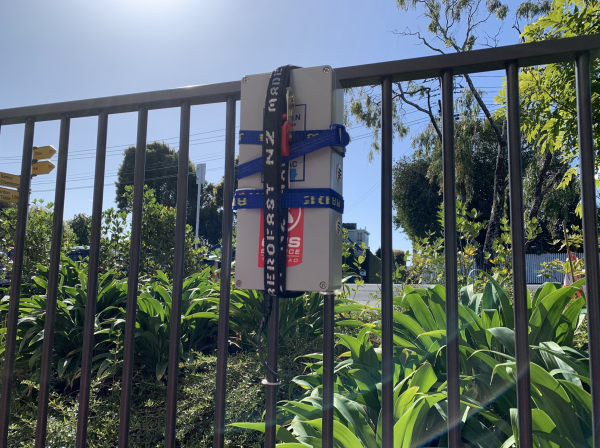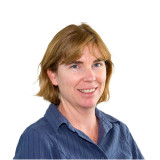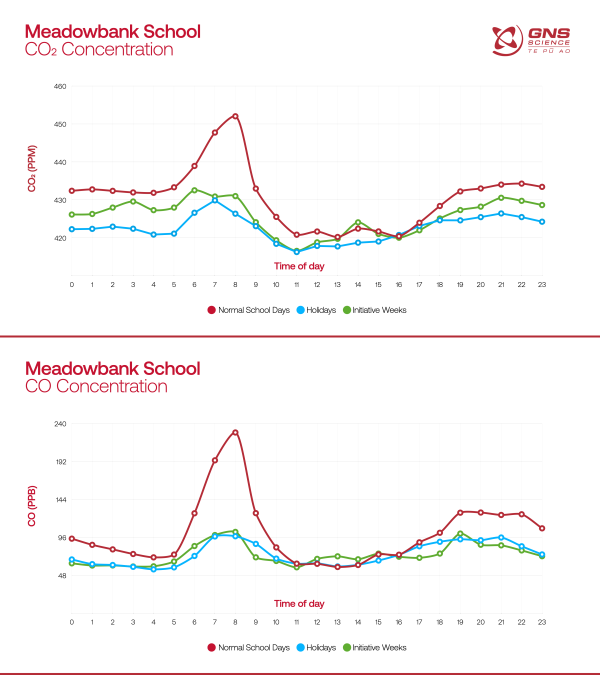Climate science inspires students to drive down school-run carbon dioxide emissions

A GNS Science atmospheric greenhouse gas sensor at an Auckland primary school gate has revealed peaks in emissions during morning drop-off, inspiring students to organise a campaign to ‘drive it down’ and reduce their carbon footprint – with spectacular results.
Cutting-edge climate science has enabled Meadowbank School students to see the invisible – how their transport choices can make a direct difference to the CO2 emissions in their local area.
An inconspicuous shoe box-sized atmospheric sensor has been measuring the CO2 and CO concentration outside the school, installed by GNS Science as part of wider work to understand urban emissions and support climate mitigation at a local level.

The data gathered showed spikes in CO2 and CO concentration in the morning that are much greater during term time compared to school holidays, indicating the daily school-run is the culprit.
Concerned by the data, the Year 6 Enviro leader students decided to take action, organising a two-week schoolwide festival of active transport activities to lower carbon emissions, including a ‘Glam your Wheels’ day for scooters and bikes, ‘Wear What Ya Want Walking Wednesday’, and a ‘Feel Good Friday’ to encourage groups of kids to walk to school together.
“It shocked us seeing the spike in the morning during drop off time and we knew we could take action to reduce this, but we needed to get the whole community involved - we couldn’t do it alone,” said Ava Moody, Meadowbank Year 6 Enviro Leader student.
GNS Science socio-economic policy specialist, Celia Wells has been working with the students throughout the initiative, and said that by bringing the specialist equipment to the school they’ve been able to help the students realise that small personal actions can make a difference.
"Because CO2 emissions are invisible, it is difficult to connect changes in our own behaviour to changes in the atmosphere."

Jocelyn Turnbull
Radiocarbon Science Leader / Lead Scientist - Rafter Radiocarbon Laboratory
View bioThe sensor has enabled the students to visualise the invisible, and it’s been exciting to see how this has captured their imaginations and inspired them to create their own campaign.
The school community put their feet and wheels whole-heartedly behind the festival, with the count of scooters being ridden to school jumping from four on the Tuesday before the initiative to 192 on the first Tuesday of the festival.

The GNS Science team continued to measure the carbon dioxide concentrations across the two-week campaign and were blown away by the results – not only was there a noticeable drop in CO2 and CO concentration, but the efforts of the school community had brought it down to school holiday levels.

“We were hopeful to see some change, but our jaws dropped when we saw the results. It shows that small changes made together can make a significant difference,” said Wells.
Transport contributes 90% of the average kiwi’s personal direct emissions – most people who drive to work and school can reduce their own emissions by around 20% simply by changing to low carbon transportation one day per week.

World-leading science applied at a community level
“The atmospheric equipment at Meadowbank is also used for science research that influences national and international policy – we’ve taken it hyperlocal to have an influence at the community level,” Wells said.
Judith Hannan, Meadowbank School Education for Sustainability Leader, said that the students have loved working with the scientists, learning more about the carbon cycle and what the data means.
“This group of students love making change and taking action, and they’ve become even more motivated because there’s science involved. It’s felt like a genuine two-way collaboration, with the students being interviewed by the GNS social scientists, which has given the students a confidence boost knowing that their voices matter,” said Hannan.
“It’s important that we listen because it’s their future.”
Auckland Council's Sustainable Schools team provided networking opportunities throughout the initiative through the Auckland Enviroschools programme.

-
Sensor connected to international network
GNS Science’s portable greenhouse gas sensor stationed at Meadowbank School is connected to the BEACO2N(external link) (Berkeley Environmental Air-quality & CO2 Network), an initiative to help understand greenhouse gas emissions in near real-time.
Data from the sensor is sent to University of California Berkeley to be calibrated, and is then analysed by GNS Science carbon cycle scientists in Wellington.
-
Afternoon atmospheric mixing
Although it is expected that the afternoon school pick-up also results in increased emissions, this is less visible in the data due to a phenomenon known as ‘atmospheric mixing’. The CO2 and CO are emitted into a layer of the atmosphere where mixing occurs. The height of this layer changes due to changes in temperature, so as the sun warms the earth’s surface throughout the day the height of the mixing layer grows and the amount of mixing increases. In the afternoon the CO and CO2 are being emitted into a larger volume and disperse more easily, resulting in a less noticeable peak.